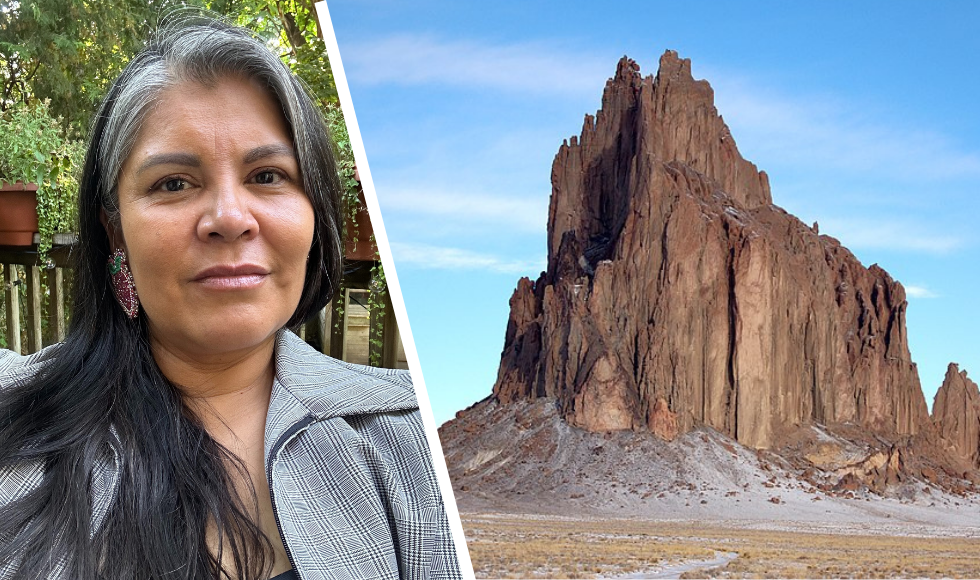Analysis: Tsé Bitʼaʼí and the importance of keeping Diné and Dene stories alive

Researcher Renae Watchman talks about her new book on Diné and Dene storytellers, how colonialism can eclipse Indigenous stories, and why those stories need to be reclaimed.
BY Chris Pickles, Faculty of Social Sciences
May 10, 2024
You’ve probably seen Tsé Bitʼaʼí, the storied geological landmark in what is currently New Mexico. You may have seen it in The Lone Ranger, or Transformers, or the most recent Jumanji film.
Known in English as Shiprock Peak, it is famous as a backdrop for Hollywood films, so much so that its original importance to the Indigenous Diné is in danger of being eclipsed.
That danger is one of the themes in Restoring Relations through Stories: From Dinétah to Denendeh, a new book by Renae Watchman, associate professor in the department of Indigenous Studies, where she specializes in Indigenous literary arts and Indigenous film.
The book explores stories — oral, literary and visual — from land-based Diné and Dene storytellers. Watchman examines the power of story to forge ancestral and kinship ties between the Diné and Dene across time and space through re-storying.
We sat down with Watchman to talk about Tsé Bitʼaʼí, and the importance of keeping Diné and Dene stories alive.
Who are the Diné and Dene?
As ancestral and linguistic relatives, it is imperative for me to clarify that today we are not culturally, linguistically, geographically, economically or politically similar.
The Diné (which means “The People”) and known by the English term Navajo, are from the southwest. Our homelands span three states: Utah, Arizona and New Mexico, and there are approximately 350,000-400,000 citizens, with about 150,000 who continue to live on our homelands.
The Dene (which also means “The People”) are from the vast geographic homelands of Denendeh, in what is currently Canada. They include several communities that include Sayisi Dene (northern Manitoba), Tsaatine (Beaver) and the Tsuut’ina (Sarcee). To the west are the eastern Gwich’in, the Kaska Dena; the far western Dene are the Tsek’ehne (Sekani), Dakelh (Carrier), and Tsilhqot’in (Chilcotin). To the north is the northern Dene Nation, composed of the Dehcho (formerly the Mackenzie Dene) and including the Łiidlįį Kuę́ (South Slavey); there are also the Tłįchǫ (Dogrib), Dënesųłiné́ (Chipewyan), Wi.li.deh (Yellowknives), Saht. Dene (North Slavey or Hare), and Mountain Dene. Each community speaks a version of Dene, illustrating the diversity of living Dene languages, though endangered.
Tell me about Tsé Bit’a’í and how it features in films
Situated in northwest New Mexico, within the four sacred mountains, Tsé Bit’a’í means “Winged Rock,” “Rock with Wings,” or “Wings of Rock”.
The English-language name of Shiprock was applied to the landmark in the late 19th century. In 1860, prior to the Navajo Long Walk to Fort Sumner, Captain J. F. McComb called Tsé Bit’a’. “The Needle.”
The Needle was replaced by the English name Ship Rock in 1870 because non-Navajo settlers believed that it resembled a nineteenth-century full-rigged sailing schooner.
This renaming reflects the unimaginative and nonsensical nautical nomenclature of the time that further stripped Tsé Bit’a’í. of her origin stories. Place naming, and naming in general, is significant to Diné and other Indigenous Peoples and the deconstruction of these colonial intrusions is critical to reclamation and restoration.
In the words of Georges Erasmus, a Dene activist from Behchokǫ̀ in what is now called the Northwest Territories: “We were no longer the actors—we were being acted upon. We were no longer naming the world—we were being named.”
In the book, I analyze two Diné-made films: Drunktown’s Finest by Sydney Freeland and 5th World by Blackhorse Lowe.
Tsé Bit’a’í does not make an appearance in Freeland’s film, but the traditional stories that inform the storyline of Drunktown’s Finest come from the body of Diné oratory.
In 5th World, Tsé Bit’a’í has a presence at the end of the film, which I discuss.
Personally, I grew up seeing Tsé Bitʼaʼí every day and spent a lot of time with my maternal grandmother. She would tell me stories of Tsé Bitʼaʼí’s origin, and I share a few origin stories of Tsé Bitʼaʼí in the first chapter.
Additionally, I was introduced to a Tsuut’ina story that told the first half of one of the stories I grew up with, which really surprised me and opened my eyes to our storied relationality (k’é), which is a central throughline of the book.
How does the example of Tsé Bitʼaʼí show the importance of keeping the Diné and Dene stories alive?
A primary argument I am making is that relations (k’é) can be restored (through the Diné philosophical concept of hózhó) through stories. I demonstrate this by examining oral stories about Tsé Bitʼaʼí in Chapter 1.
I then move on to analyze two distinct films — informed through oral stories that highlight the various underworlds (of our journey narratives) — that restore contemporary young people to our stories.
Later, I turn to literary critique of Dene literature and connect the Dene laws to hózhó, which restores traditional stories of our people, ultimately to facilitate the restoration of the Diné and Dene across our kinscapes.
Renae Watchman’s book is being published in Canada by the University of Regina Press on May 16. The book was released in the United States in April by the University of Arizona Press.


